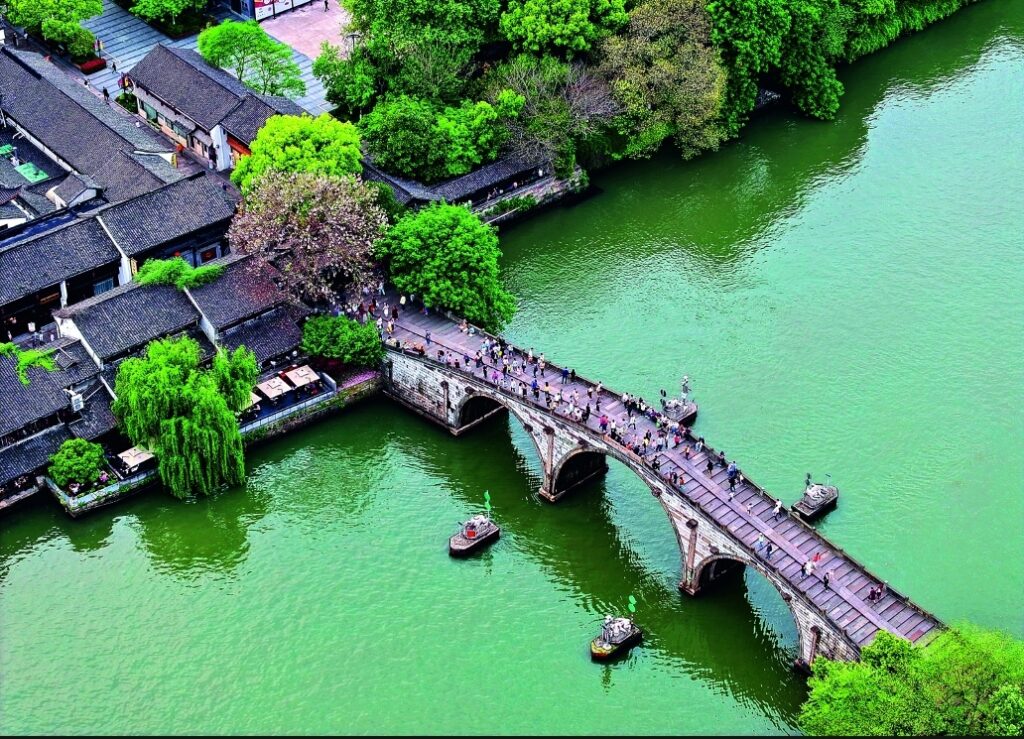An aerial view of the Qiaoxi Historical and Cultural Block in Hangzhou, China’s eastern Zhejiang Province, April 14, 2024. Situated at the southern end of the Beijing–Hangzhou Grand Canal, the block was named after the west bank of the Gongchen Bridge, and it is designated a national-level tourism and leisure block. (Photo by Zhou Fangling)
By Loro Horta
Many Western observers tend to express biased opinions on China’s environmental policy. A mere decade ago, Western media were full of reports about the pollution in China’s major cities as well as rivers and lakes. Although some of these reports were not exaggerated, none of these same critics have cared to notice China’s recent achievements in improving its environment.
A decade ago, China was indeed facing a severe environmental problem. Chinese officials reported that China lost about 80,200 hectares of farmland in 2013. The same year, Chinese authorities estimated that nearly 30 percent of the country’s rivers were polluted.
While Western media criticized China for lack of transparency, the statistics mentioned above were all made public by relevant Chinese authorities. China did not hide its problems and made serious efforts to reverse the damage.
Another consistently conspicuous absence in most Western narratives was the context in which China’s environmental degradation took place. Following the opening-up of the Chinese economy in the late 1970s, China experienced massive economic growth. In 40 years, China lifted more than 700 million people out of poverty. This was an unprecedented achievement in human history.
As one would expect, this rapid development and industrialization came at a heavy cost for the environment. The West endured a very similar process in the late 19th century and well into the mid-20th century. London was the most polluted city in the world for a long time. Even in the 1980s, most of Europe’s rivers were still heavily polluted.
China had to pay the same price as the West did for its development in terms of environmental degradation. However, the country faced much bigger challenges due to its massive population. China must feed and provide health and education for over 1.4 billion people. That’s more than twice the population of all EU members plus the UK.
Having modernized the country and significantly improved the lives of its people, the Chinese leadership is determined to build a clean, beautiful China. Creating a Green China has become a top priority of the country and its people.
One of the greatest achievements of the Chinese people in recent years has been in reforestation. In the 1990s, China launched an unprecedented extensive reforestation program. In 2015, forest coverage reached 21.63 percent of China’s vast territory, up from around 16 percent in 1990, and China aims to achieve 26 percent forest coverage by 2050. No other nation has even come close.
China has made tremendous advances in fighting desertification and is leading worldwide efforts in the fight against desertification. For instance, China is helping several African countries build a Great Green Wall to stop the Sahara desert’s advance.
A decade ago, some Chinese cities were ranked among the 10 most polluted in the world, but in 2024, not a single Chinese city appeared on the list. Progress has been seen across dozens of Chinese cities. Major cities such as Beijing, Shanghai, Shenzhen, and others shifted from car-centric infrastructure to become public-transport-oriented. Today, China has the most advanced rail network in the world.
China has large coal reserves and for decades it relied heavily on this source of energy. In 2024, the share of energy generated from coal fell to 53.2 percent in the country. Especially in the first half of 2024, China reduced coal power permits by 83 percent year-on-year. By 2023, the water quality in China’s seven major rivers was also greatly improved. Chinese President Xi Jinping has made the environment one of his top priorities, hoping to build an ecological civilization. The prospects look promising.
China has emerged as the world’s leading producer of clean technology. Chinese electric vehicle maker BYD is the largest manufacturer of electric cars in the world. Cars are the main source of air pollution in cities around the globe. China’s electric car revolution is contributing to a rapid improvement in air quality throughout the country. Additionally, the quality and affordability of Chinese electric cars allow developing nations to acquire such vehicles. BYD is considering opening a large plant in Mexico, a country with a population of 130 million people. China is also the world’s leader in the manufacturing of solar panels.
China is not just improving its own environment; it is assisting the world in this noble cause. China is determined to achieve its dream of building an ecological civilization.
Ironically, as China is fully embracing the environment and investing big in clean and renewable technologies, the United States is returning to fossil fuel. In the United Kingdom, a recent study concluded that the country’s rivers are more polluted today than they were in the 1980s.
It doesn’t seem like a great time for glass house inhabitants to begin picking up stones.
About Author:
The author is a diplomat and scholar from Timor Leste. He is currently the ambassador of the Democratic Republic of Timor Leste to the People’s Republic of China. The views expressed here are strictly his own.



